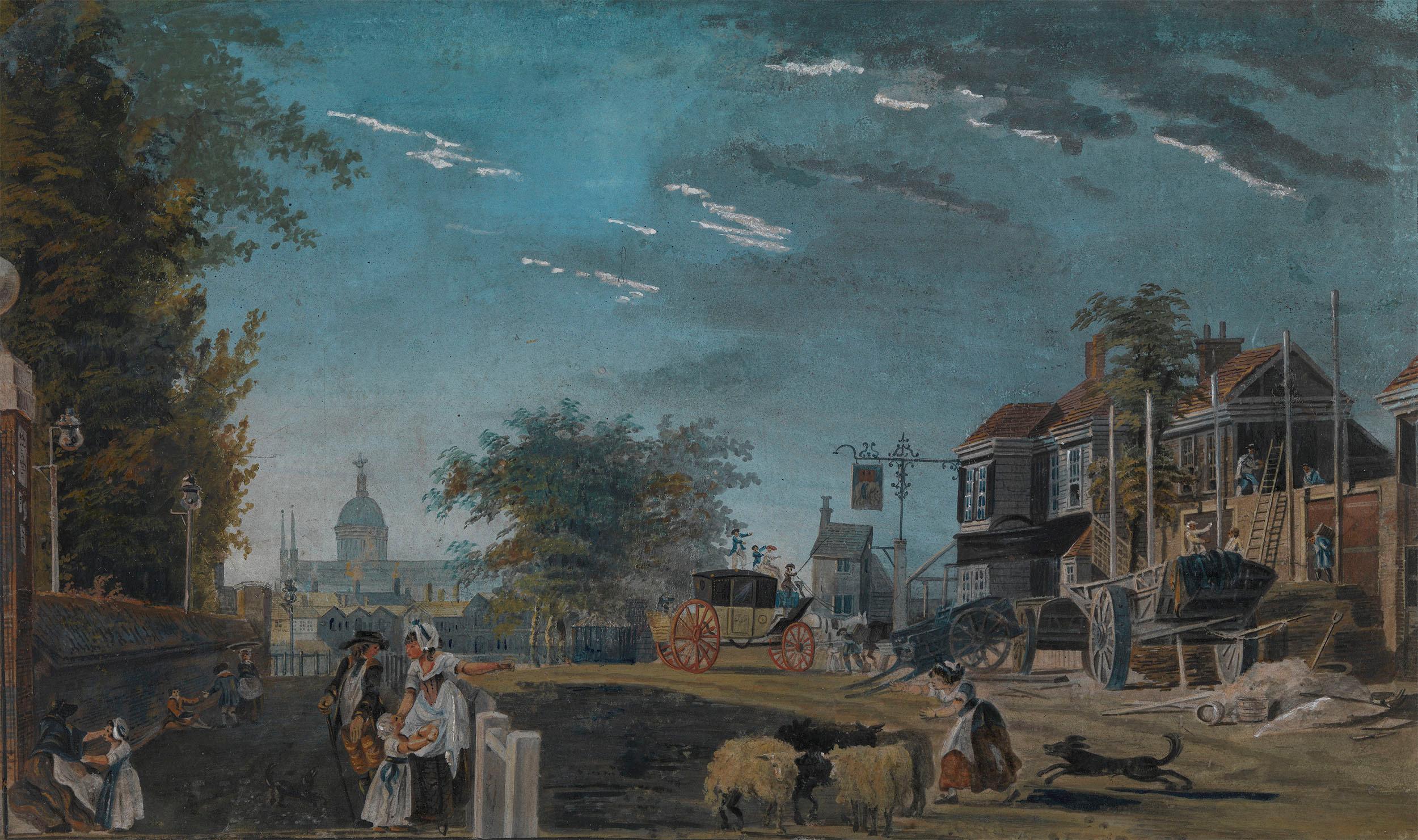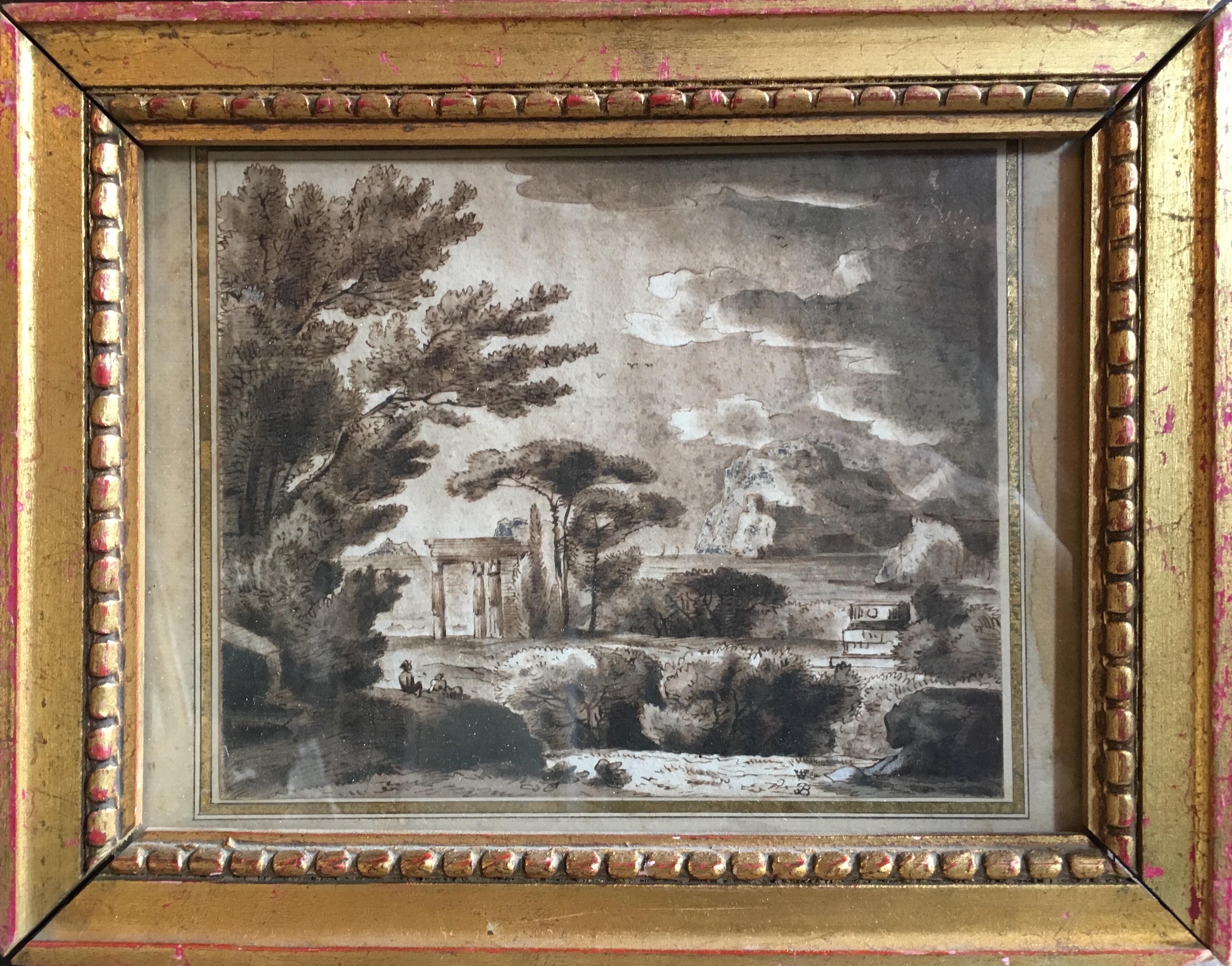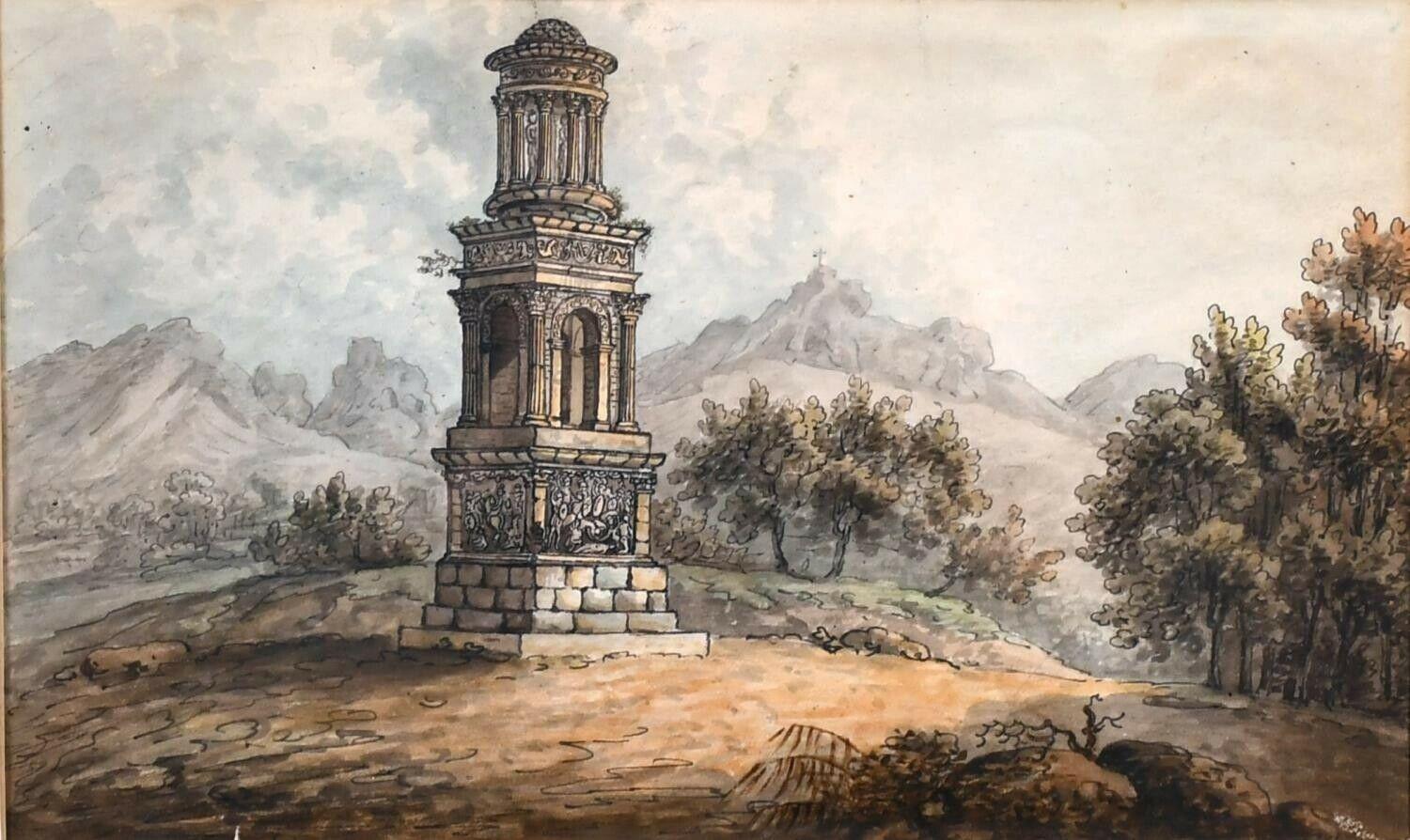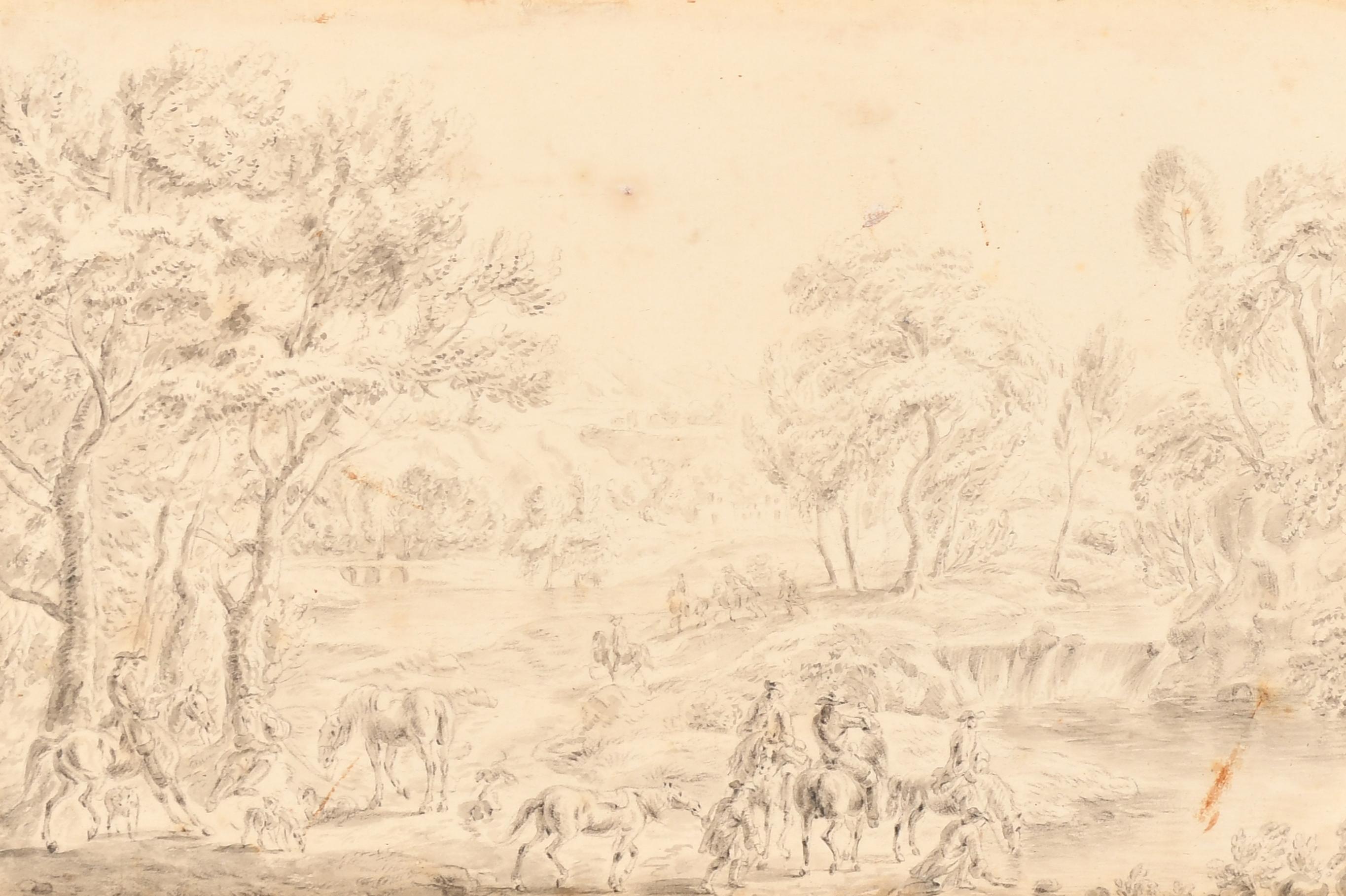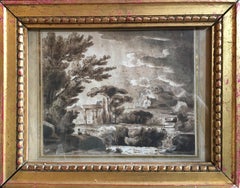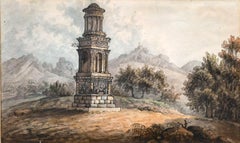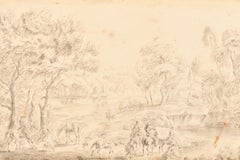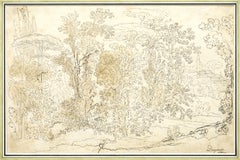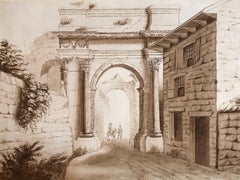
Classical Roman Ruins, c. 1840 drawing
View Similar Items
Want more images or videos?
Request additional images or videos from the seller
1 of 10
UnknownClassical Roman Ruins, c. 1840 drawingc. 1840's
c. 1840's
About the Item
- Creation Year:c. 1840's
- Dimensions:Height: 12 in (30.48 cm)Width: 13.25 in (33.66 cm)
- Medium:
- Movement & Style:
- Period:
- Condition:
- Gallery Location:Cirencester, GB
- Reference Number:1stDibs: LU50933238061

About the Seller
5.0
Platinum Seller
These expertly vetted sellers are 1stDibs' most experienced sellers and are rated highest by our customers.
Established in 1989
1stDibs seller since 2016
3,485 sales on 1stDibs
Typical response time: 2 hours
More From This SellerView All
- Classical Landscape, Original Glazed Frame, SignedLocated in Cirencester, GloucestershireGrand Tour Study Italian School, 18th century monogrammed, lower right hand corner, Watercolour wash painting on board, glazed frame Framed size: 9 x 11 inches The painting captures...Category
18th Century Old Masters Landscape Paintings
MaterialsWatercolor
- 18th CENTURY FRENCH GRAND TOUR WATERCOLOUR - ROMAN MONUMENT ST. REMY PROVENCELocated in Cirencester, GloucestershireArtist/ School: French School, 18th century Title: The Roman Ruins at St. Remy de Provence, France. Inscribed verso to the frame: ‘Ruins at Roman Monument...Category
18th Century Old Masters Landscape Paintings
MaterialsWatercolor
- Fine 17th Century Dutch Old Master Watercolor Drawing Hunting Party LandscapeLocated in Cirencester, GloucestershireThe Hunting Party Attributed to Dirk Maes (1659-1717) Dutch. Figures in a Classical Landscape, Watercolour and wash on paper, Mounted, unframed image 6.75" x 9.75" (17.1 x 24.7cm)...Category
17th Century Old Masters Landscape Paintings
MaterialsWatercolor
- 18th C Italian Classical Grand Tour Ancient City Old Ruins & FiguresLocated in Cirencester, GloucestershireTitle: The Italian City Artist/ School: English/ Italian School, late 18th century; a Grand Tour work. Medium: pencil drawing. Size: 6.75 x 9.75 inches Provenance: from a priva...Category
Late 18th Century Old Masters Landscape Drawings and Watercolors
MaterialsPencil
- HUGE 17thC ITALIAN OLD MASTER OIL PAINTING - KING & COURT FIGURES ROMAN BUILDINGLocated in Cirencester, GloucestershireArtist/ School: Italian School, 17th century. Title: A King and Queen before court figures, amidst a classical landscape with Roman columns. Medium: oil painting on canvas, framed ...Category
17th Century Old Masters Figurative Paintings
MaterialsOil, Canvas
- 1700’s Flemish Old Master Oil Shepherds & Animals Sunset Landscape ViewLocated in Cirencester, GloucestershireMarc Baets (Flemish 1720 - 1785), follower of Pastoral Scene oil painting on canvas, framed framed: 23 x 29 inches canvas : 17 x 23 inches provenance: private collection, England c...Category
Mid-18th Century Old Masters Landscape Paintings
MaterialsOil
You May Also Like
- Italian Landscape, a drawing by Louis-Jean Desprez (1743 - 1804)Located in PARIS, FRThis landscape, masterfully executed in pen and wash by Louis-Jean Desprez around 1779, probably represents a view of the Roman countryside. The treatment of the trees is very similar to that of two engravings which Desprez executed in Rome, The Island of Cythera and The Temple of Love. 1. Louis-Jean Desprez, a cosmopolitan life between Italy and Sweden Born in Auxerre in 1743, Louis-Jean Desprez probably began his apprenticeship with the engraver Charles-Nicolas Cochin...Category
1770s Old Masters Landscape Drawings and Watercolors
MaterialsCarbon Pencil, Ink
- 18th century view of the Elephant and Castle in LondonLocated in London, GBCollections: With Martyn Gregory; Judy Egerton, 1984, acquired from the above; By descent to 2014. Exhibited: London, Martyn Gregory, Exhibition of English & Continental Watercolours, 1984, no. 94. London, Lowell Libson...Category
18th Century Old Masters Landscape Paintings
MaterialsVellum, Gouache
- BrooklynBy Arozarena De La FuenteLocated in Mexico City, MXThis painting is done on flight ticket prints, the artists added wires delicately in order to give it a 3D feeling and achieve the shadow projections on the bridge. The perspective i...Category
2010s Contemporary Landscape Paintings
MaterialsWire
- Pavilion with waterfall, an ink wash attributed to Hubert Robert (1733 - 1808)By Hubert RobertLocated in PARIS, FRThis large wash drawing is a slightly enlarged version of a composition executed by Hubert Robert in 1761, at the end of his stay in Rome. This composition is a marvellous synthesis of the painter's art: the clatter of the waterfall, in a grandiose setting inspired by antiquity, is opposed to the intimacy of a genre scene, made up of a few peasant women performing some agricultural work. 1. The stay in Italy, an important founding stage in Hubert Robert's carrier Hubert Robert came from a privileged family of Lorraine origin, linked to the Choiseul-Stainville family, where his father was an intendant. The protection of this powerful aristocratic family enabled him to study classical art at the Collège de Navarre (between 1745 and 1751). After a first apprenticeship in the workshop of the sculptor Slodtz (1705 - 1764), he was invited by Etienne-François de Choiseul-Beaupré-Stainville (the future Duke of Choiseul, then Count of Stainville) to join him in Rome when the latter had just been appointed ambassador. Hubert Robert arrived in Rome on 4 November 1754, aged twenty-one, and remained there until 24 July 1765. Thanks to his patron, he obtained a place as a pensioneer at the Académie de France without having won the prestigious Prix de Rome. On his arrival in Rome, he frequented the studio of the painter Giovanni Paolo Panini (1691 - 1765), the inventor of the ruins painting, and also benefited from the proximity of Giovanni Battista Piranesi’s studio (1720 - 1778). During his eleven-year stay in Rome, Hubert Robert studied the great Italian masters and drew many of the great archaeological sites, multiplying the sketches which he would use throughout his career, becoming one of the masters of the "ruin landscape". Back in Paris in 1765, he was very successful. He was accepted and admitted to the Royal Academy of Painting and Sculpture on the same day, July 26th 1766, which was very unusual. He was appointed draughtsman of the king's gardens in 1784, then guard of the Royal Museum from 1784 to 1792. Arrested in 1793 and detained in the prisons of Sainte Pélagie and Saint-Lazare, he was released in 1794 after the fall of Robespierre and undertook a second trip to Italy. In 1800, Hubert Robert was appointed curator of the new Central Museum and died at his home in Paris in 1808. 2. Description of the artwork This composition, formerly called "La Cascade du Belvédère Pamphile" , is undoubtedly inspired by the water theatres of the Frascati villas. Hubert Robert presents a hemicycle of columns with rustic bossages at the foot of which is a cascade of water falls into a basin. The hemicycle is flanked by two high walls, pierced by window wells topped with antique masks...Category
1760s Old Masters Landscape Drawings and Watercolors
MaterialsInk, Watercolor
- A landscape drawing by Claude Lorrain, with a preliminary sketch on the versoBy Claude LorrainLocated in PARIS, FRThis study presents a typical Roman countryside landscape: an ancient mausoleum in front of which a cart is passing by followed by two peasants. If the technique (a pen drawing on graphite lines, completed with a wash of brown and grey inks) and the signature inevitably evoke the art of Lorrain, we find on the verso of this drawing additional evidences that lead us to consider this unpublished drawing as a work by the master. The motif of the mausoleum has been taken up in pen on the verso in a technique that can be found in several other drawings by Lorrain. There is also a study of three characters, which can be considered as preparatory to Lorrain’s painting entitled The Port of Ostia with the Embarkation of Saint Paula, leading us to claim this attribution with a dating of around 1629. 1. Claude Lorrain or the perfection of classical landscape in Rome in the 17th century Claude Gellée was born in 1600 in Chamagne in Lorraine. Orphaned at the age of twelve, he spent a year with his brother in Freiburg, where the latter was a woodcarver. Claude Gellée then probably arrived in Rome in 1613, where he joined the workshop of Agostino Tassi (1580 - 1644) in 1617. Between 1619 and 1620 he studied for two years in Naples in the workshop of Goffredi Wals (who was himself a former pupil of Tassi). In 1625 he returned to Lorraine for two years where he worked alongside Claude Deruet. He then returned to Rome, a city he never left for the rest of his life (except for short trips to the surrounding countryside). From 1627 to 1650 he lived in Via Margutta. From 1635 onwards he became a renowned painter and commissions started to pour in. Considered during his lifetime as the most accomplished of the classical landscape painters, his reputation never faded. Between 1629 and 1635 Le Lorrain often went to the Roman countryside to draw with his friend Joachim von Sandrart (1606 - 1686). He became a member of the Academy of Saint Luke in 1633, while being closely acquainted with the Bentvueghels, this guild which brought together the young Nordic painters active in Rome. In 1643 he joined the Congregation of the Virtuosi. In 1650 he moved to Via Paolina where he lived until his death. Little is known of his intimate life. He seems to have had a daughter, Agnes, from an ancillary love affair. In 1657/ 1658 she moved in with him. Stricken with gout in 1663, he died in 1682. 2. Description of the drawing; the technique of nature studies Two peasants are walking behind a horse-drawn cart on a road that winds through ancient tombs. While a rectangular tomb with a columned facade can be seen in the distance, the cart passes an important ancient building. It has a circular shape and its partially ruined façade is decorated with columns. The start of a second floor can...Category
1660s Old Masters Landscape Drawings and Watercolors
MaterialsInk, Pen, Graphite
- A WolfLocated in New York, NYProvenance: The Marchesi Strozzi, Palazzo Strozzi, Florence Sale, Christie’s, London, May 20, 1993, lot 315, as by Carl Borromaus Andreas Ruthart...Category
17th Century Old Masters Animal Paintings
MaterialsPaper, Canvas, Oil
Recently Viewed
View AllMore Ways To Browse
Grand Tour Architectural Watercolors
White House Garden
Celebrate 2000
California Impressionist Plein Air
Vintage Irish Art
18 C Landscapes
St Michael
Vintage Graduation
Park Nyc
3 Sons Painting
Late 19th Century Oil American
Dutch War
Winter Scene Oil
Southwest Designs
Gold Framed Large Oil Painting
Four Early 1970
Snow Tree
German 19th Century Oil

